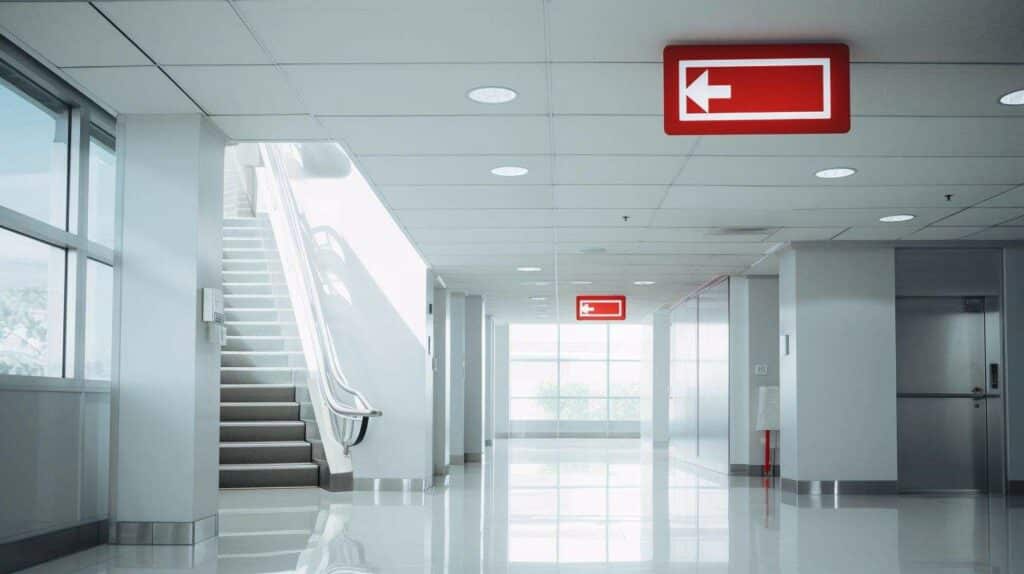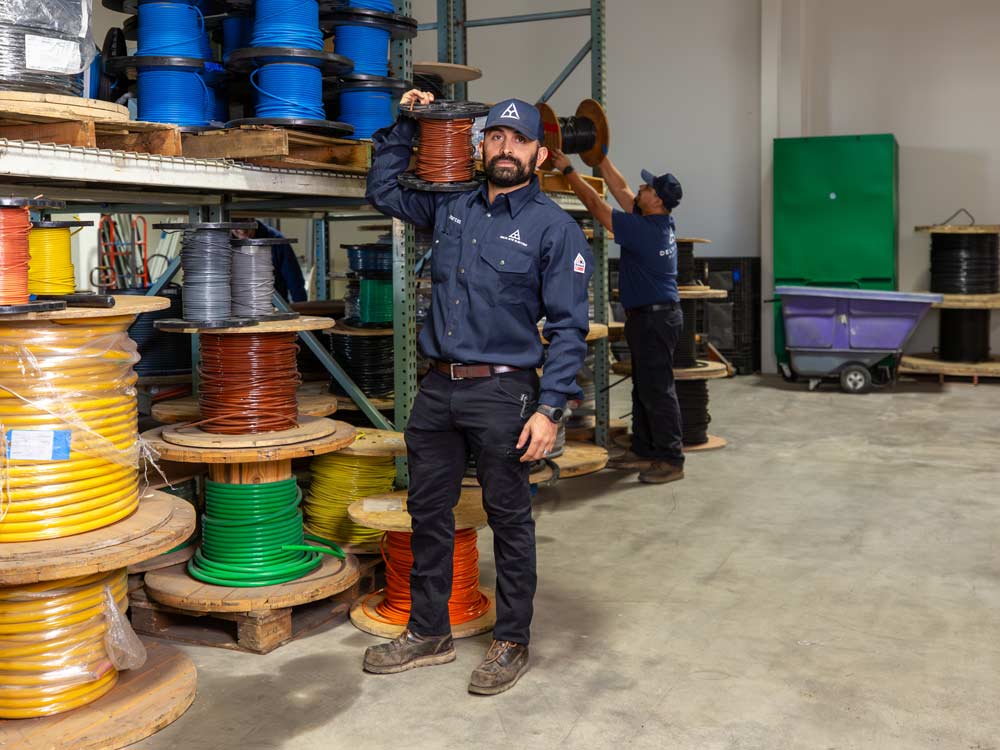Safety is paramount, especially during emergencies. Whether it’s a sudden power outage or a fire incident, having the proper measures to protect lives and facilitate the safe evacuation of occupants is crucial. One such measure that plays a pivotal role in emergencies is installing an emergency lighting system. This article will delve into emergency lighting systems, discussing their definition, components, features, and different types available.
Understanding Emergency Lighting Systems
The purpose of emergency lighting systems is to provide illumination in the event of a power outage or failure of the primary lighting source. These systems ensure that occupants can safely navigate to exits, stairwells, and other crucial areas during an emergency. They serve as a dependable backup, delivering adequate lighting when needed most.
It is a network of lighting fixtures installed to activate automatically during a power outage or emergency. Backup batteries or generators typically power these systems, enabling them to operate independently of the main power supply.
Delta Wye‘s role in implementing such systems is vital, as they ensure that the emergency lighting is effective and adheres to the stringent standards required in industrial environments.
Components and Features of an Emergency Lighting System
An emergency lighting system consists of various components that provide reliable illumination. These include:
- Emergency Light Units are the light fixtures strategically placed throughout a building or space. They are designed to activate during emergencies automatically and may include emergency exit signs, bulkhead lights, and spotlights.
- Power Source: Emergency lighting systems are powered by backup batteries or generators. Batteries provide short-term power during temporary outages, while generators can sustain the system for an extended period.
- Emergency Lighting Control and Monitoring Systems: Modern emergency lighting systems often feature intelligent control and monitoring capabilities. These systems can automatically perform tests, monitor the health of the batteries, and send alerts if any issues are detected.
Types of Emergency Lighting Systems

Based on their purpose and application, we categorize emergency lighting systems into different types. Some common types include:
- Escape Route Lighting: This type of emergency lighting illuminates the pathways leading to exits, stairwells, and assembly points. Emergency escape lighting systems ensure occupants can safely find their way out of the building without confusion or delays.
- High-Risk Task Area Lighting: These systems illuminate areas where critical tasks must be completed during an emergency. Examples include operating rooms in hospitals or control rooms in industrial facilities.
- Anti-Panic Lighting: Anti-panic lighting minimizes panic and stress during emergencies. It ensures that even without regular lighting, occupants can see clearly and move in an organized manner.
- Standby Lighting: Standby lighting systems illuminate areas where essential activities, such as security monitoring or data center operations, must continue uninterrupted during a power outage.
Understanding the various types of emergency lighting systems allows building owners and facility managers to choose the most suitable option for their specific emergency lighting requirements, ensuring the safety and well-being of occupants in critical situations.
In the next section of this article, we will explore the benefits of installing an emergency lighting system, emphasizing why it is a wise investment for any building or space.
Benefits of an Emergency Lighting System
An emergency lighting system offers numerous benefits that are crucial in ensuring safety, minimizing panic and confusion, enhancing security and emergency response, and protecting valuable assets. Let’s explore these benefits in more detail:
Ensuring Safety and Evacuation
During power outages or emergencies, an emergency lighting system provides essential illumination, allowing occupants to navigate safely. This lighting ensures that people can quickly locate exits, stairwells, and evacuation routes, reducing the risk of accidents or injuries.
According to the National Fire Protection Association (NFPA), between 2016 and 2020, there were an estimated average of 343,000 reported structure fires in the United States alone. An effective emergency lighting system can significantly improve the chances of a successful evacuation during such incidents.
Moreover, an emergency lighting system ensures compliance with safety regulations and codes set by various authorities. These regulations provide the safety and well-being of occupants in buildings or spaces.
Minimizing Panic and Confusion
Darkness-induced panic and disorientation can be incredibly dangerous during emergencies. An emergency lighting system mitigates these risks by providing sufficient illumination to maintain a sense of calm and order. Clear paths, signage, and designated emergency exits are all illuminated, reducing confusion and ensuring people can quickly and safely evacuate.
Enhancing Security and Emergency Response
Emergency lighting systems are vital in enhancing security and emergency response measures. When emergency personnel arrive at a building, the availability of well-lit exit routes and critical areas enables them to quickly and effectively carry out their duties. Clear visibility of exits and essential equipment helps emergency responders coordinate their actions and respond swiftly.

A study published in the Journal of Environmental Psychology found that well-designed emergency lighting systems significantly improve the accuracy and speed of emergency response teams in locating exits during emergencies.
Additionally, emergency lighting solutions enable quick and efficient decision-making. In high-stress situations, having a well-lit environment aids emergency personnel in assessing the situation, formulating strategies, and executing necessary actions promptly.
Protecting Valuable Assets
Emergency lighting systems also help protect valuable assets, such as property, equipment, and data. By reducing potential damage due to negligence or accidents, these systems contribute to loss prevention efforts. Moreover, during power failures, emergency lighting systems ensure the continued operation of critical systems and minimize disruptions to essential services.
The U.S. Department of Energy estimates that power outages cost the U.S. economy $150 billion annually. An effective emergency lighting system can significantly mitigate these financial losses by maintaining operations during power failures and preventing damage to valuable assets.
In conclusion, installing an emergency lighting system offers many benefits. These systems are indispensable to any well-prepared building or space, from ensuring safety and smooth evacuation to minimizing panic and confusion, enhancing security and emergency response, and protecting valuable assets. Investing in the right emergency lighting solution can help safeguard lives, prevent damage, and ensure the overall resilience of your facility.
Key Considerations for Installing an Emergency Lighting System
Installing an effective emergency lighting system requires careful consideration of various factors. By addressing these fundamental considerations, you can ensure that your emergency lighting system meets the specific requirements of your building or space. Let’s explore these considerations in detail:
Assessing Building Requirements
Before selecting an emergency lighting system, it is essential to assess the specific requirements of your building or space. This includes:
- Identifying the purpose and occupancy: Different buildings or spaces have distinct purposes and levels influencing the necessary safety measures. Consider factors such as occupants’ number, mobility, and potential limitations.
- Evaluating potential emergency scenarios and risks: Assess the possible emergencies in your building or space. Engage with safety experts or conduct risk assessments to identify specific risks that may influence your emergency lighting needs, such as fire, power outages, or natural disasters.
- Determining the necessary illumination levels: The appropriate levels may vary based on your building or space’s size, layout, and usage. Consider factors such as obstacles, distance to exits, and any specific requirements for hazardous areas.
Choosing Appropriate Lighting Technology
Selecting the right lighting technology is crucial for the efficiency and effectiveness of your emergency lighting system. Consider the following:
- Exploring emergency lighting systems: There are various types, from self-contained units to centrally controlled systems. Evaluate the advantages and disadvantages of each type to determine which best suits your needs.
- Considering LED technology for energy efficiency and longevity, LED (Light Emitting Diode) lights are highly recommended for emergency lighting systems due to their energy efficiency and long lifespan. LED lamps consume less energy, resulting in cost savings, and require less frequent replacement, reducing maintenance efforts.
- Evaluating features like automatic testing and monitoring: Some emergency lighting systems offer automatic testing and monitoring capabilities. These features ensure the system functions correctly and proactively detects any issues. Consider the benefits of these features for ease of maintenance and system reliability.
Proper Placement and Distribution

Proper placement and distribution of emergency lights ensure adequate emergency coverage and visibility. Consider the following:
- Understanding the recommended spacing and location of emergency lights: Consult safety regulations and codes to determine the recommended spacing and location. Install lights at appropriate intervals to ensure consistent coverage throughout the building or space.
- Ensuring coverage of exits, stairways, hallways, and vital areas: Focus on illuminating critical areas, such as exits, stairways, hallways, and areas with complex layouts. Pay particular attention to areas where potential risks or obstacles may hinder evacuation.
- Addressing specific needs for different types of buildings or spaces: Different types of buildings or spaces (e.g., hospitals, schools, offices) may have unique requirements. Consider specific needs, such as emergency lighting for equipment or areas requiring continuous operation during a power failure.
Regular Maintenance and Emergency Lighting Testing
Regular maintenance and testing are vital to ensure the operational readiness of your emergency lighting system. Consider the following:
- Importance of regular inspections and testing: Implement a schedule for regular inspections and testing of your emergency lighting system. Regular inspections and testing ensure that all components of your emergency lighting system function correctly and that any issues are identified and resolved promptly.
- Compliance with regulations and codes: Stay abreast of safety regulations and codes governing emergency lighting systems. Regularly review and update your emergency lighting system to ensure compliance with these standards.
- Ensuring the operational readiness of the emergency lighting system: Regular testing and maintenance are essential for ensuring that your emergency lighting system is reliable and ready to perform during emergencies. Conduct periodic tests to verify proper operation and promptly address deficiencies or malfunctions.
By carefully addressing these key considerations, you can ensure that your industrial or commercial building’s emergency lighting system is tailored to its specific requirements. Regular maintenance, compliance with regulations, and thorough testing will help to maintain the effectiveness and reliability of your emergency lighting system, providing peace of mind in times of crisis.
Final Thoughts
In conclusion, an emergency lighting system protects lives and property during emergencies. It ensures safe evacuation by providing illumination, minimizing panic and confusion, enhancing security and emergency response, and protecting valuable assets. It is highly recommended to take preventative measures to install an emergency lighting system, including considering building needs, selecting appropriate lighting technology, ensuring adequate installation, and performing regular maintenance and testing. Investing in this essential safety measure allows you to be prepared and confidently safeguard lives and property during critical situations.
Don’t leave safety to chance. Contact Delta Wye today to discuss how our industrial electrical construction and engineering expertise can enhance your emergency lighting system. Our team is ready to assist you in selecting the right technology, installing it to the highest standards, and maintaining it to ensure optimal performance. Take charge of your emergency preparedness and protect your facility with Delta Wye’s reliable solutions.
Reach out to Delta Wye— because every second counts regarding safety.









